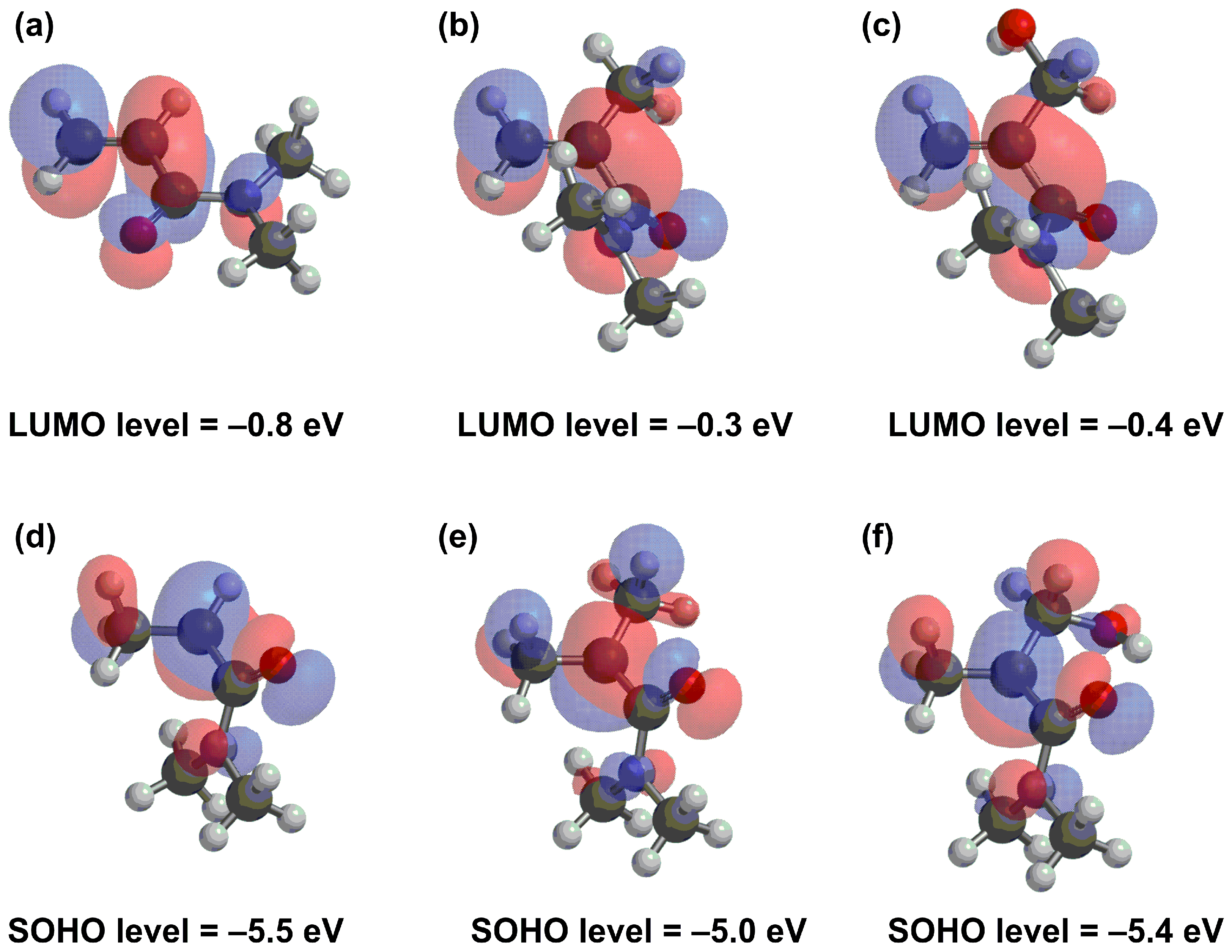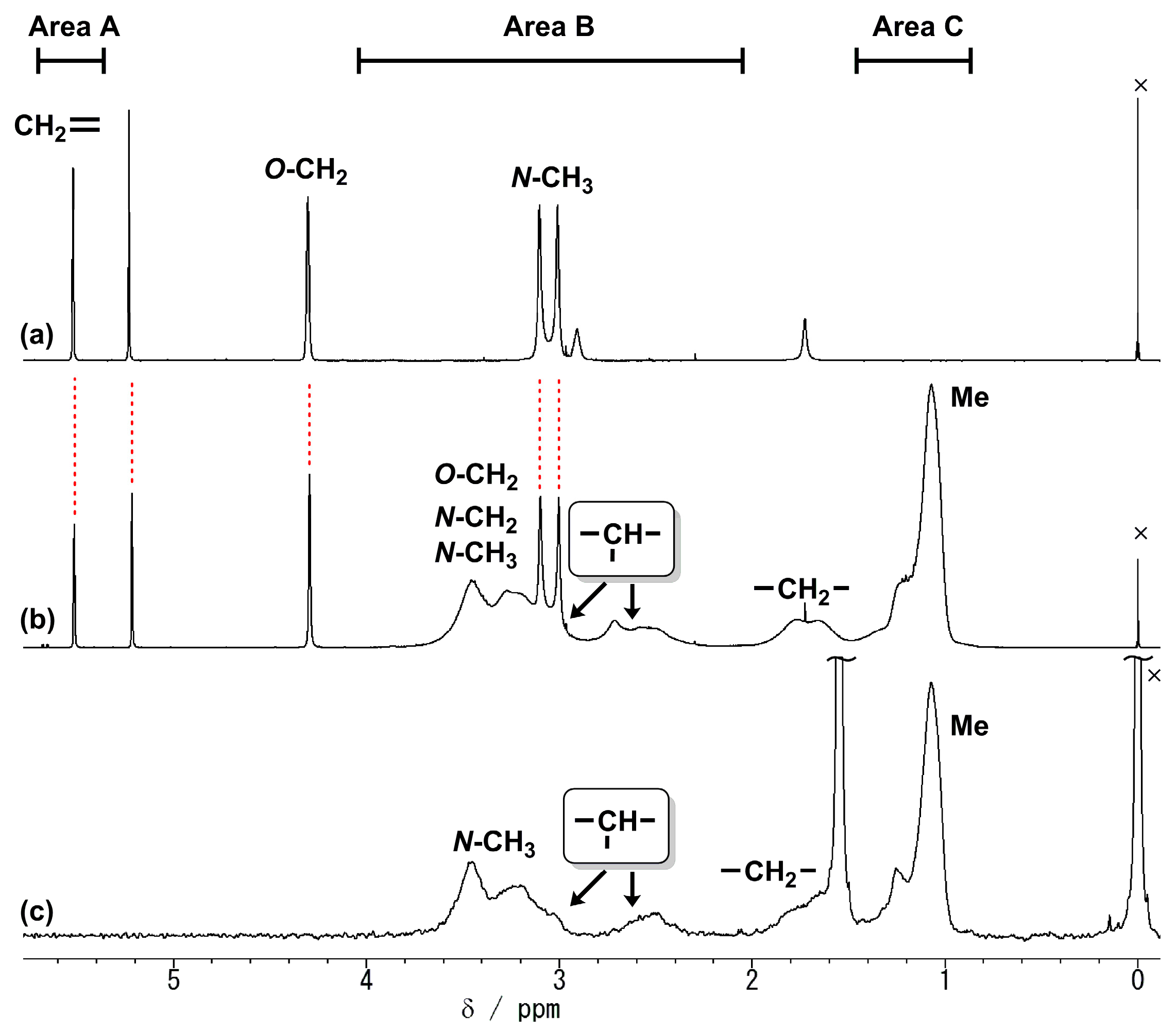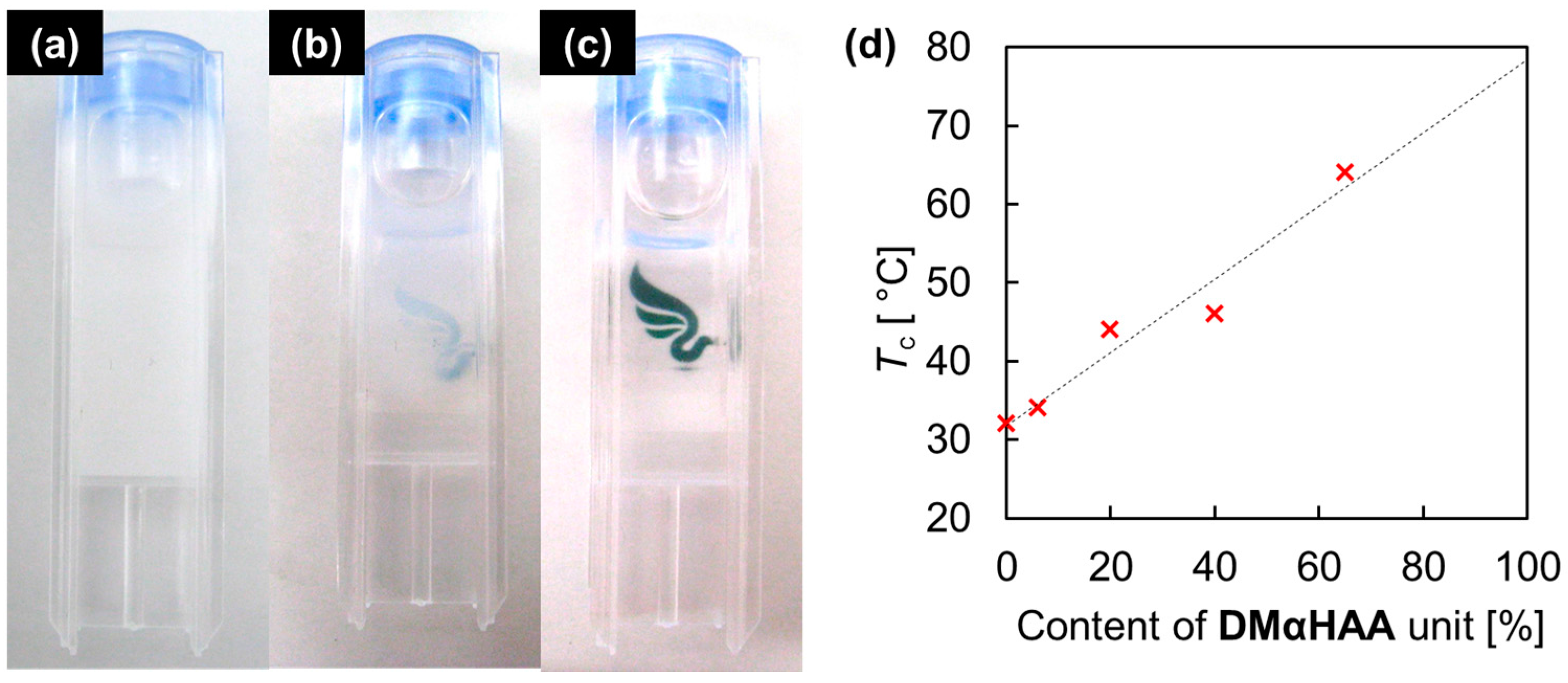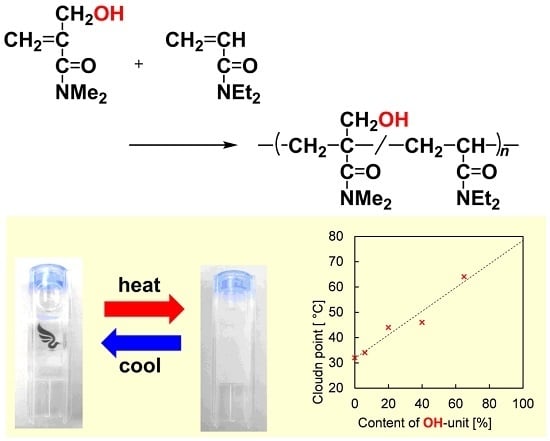Synthesis of Thermo-Responsive Polymer via Radical (Co)polymerization of N,N-Dimethyl-α-(hydroxymethyl)acrylamide with N,N-Diethylacrylamide
Abstract
:1. Introduction
2. Experimental Section
2.1. Materials
2.2. Instruments
2.3. Synthesis of N,N-Dimethyl-α-(hydroxymethyl)acrylamide [21]
2.4. Radical Polymerization
2.5. Observation of Cluod Point
2.6. Density Functional Theory (DFT) Calculations
3. Results and Discussion
3.1. Attempted Homopolymerization of DMαHAA
3.2. Copolymerization of DMαHAA with DEAA
- Area A (5.75–5.35 ppm) includes the vinylidene signal of the unreacted monomer.
- Area B (4.05–2.05 ppm) includes the N–CH2 and main-chain CH signals in DEAA units, the N–CH3 and O–CH2 signals in DMαHAA units, and the N–CH3 signals of unreacted DMαHAA.If we set the content of DMαHAA units as x (%), the following equation can be established:[Area B] − 6 × [Area A] (N-CH3 of unreacted DMαHAA) = 4x (N-CH2) + x (CH) + 6 × (100 − x) (N-CH3) + 2 × (100 – x) (O-CH2)
- Area C (1.45–0.85 ppm) includes the N–CH2CH3 signal in DEAA units, and thus the following equation can be established:[Area C] = 6x (N-CH2CH3)
3.3. Syntheses of Thermo-Responsive Polymers with Tunable Cloud Points
4. Conclusions
Supplementary Materials
Acknowledgments
Author Contributions
Conflicts of Interest
References
- Aoshima, S.; Kanaoka, S. Synthesis of stimuli-responsive polymers by living polymerization: Poly(N-isopropylacrylamide) and poly(vinyl ether)s. Adv. Polym. Sci. 2008, 210, 169–208. [Google Scholar]
- Rimmer, S.; Soutar, I.; Swanson, L. Switching the conformational behaviour of poly(N-isopropyl acrylamide. Polym. Int. 2009, 58, 273–278. [Google Scholar] [CrossRef]
- Tada, T.; Hirano, T.; Ute, K.; Katsumoto, Y.; Asoh, T.; Shoji, T.; Kitamura, N.; Tsuboi, Y. Effects of syndiotacticity on the dynamic and static phase separation properties of poly(N-isopropylacrylamide) in aqueous solution. J. Phys. Chem. B 2016, 120, 7724–7730. [Google Scholar] [CrossRef] [PubMed]
- Uhlig, K.; Boerner, H.G.; Wischerhoff, E.; Lutz, J.-F.; Jaeger, M.S.; Laschewsky, A.; Duschl, C. On the interaction of adherent cells with thermoresponsive polymer coatings. Polymers 2014, 6, 1164–1177. [Google Scholar] [CrossRef]
- Chen, W.; Ma, Y.; Pan, J.; Meng, Z.; Pan, G.; Sellergren, B. Molecularly imprinted polymers with stimuli-responsive affinity: Progress and perspectives. Polymers 2015, 7, 1689–1715. [Google Scholar] [CrossRef]
- Katsumoto, Y.; Etoh, Y.; Shimoda, N. Phase diagrams of stereocontrolled poly(N,N-diethylacrylamide) in water. Macromolecules 2010, 43, 3120–3121. [Google Scholar] [CrossRef]
- Hufendiek, A.; Trouillet, V.; Meier, M.A.R.; Barner-Kowollik, C. Temperature responsive cellulose-graft-copolymers via cellulose functionalization in an ionic liquid and RAFT polymerization. Biomacromolecules 2014, 15, 2563–2572. [Google Scholar] [CrossRef] [PubMed]
- Fukuda, K.; Enomoto, R.; Ishihara, K.; Morishima, Y.; Yusa, S. Thermo-responsive and biocompatible diblock copolymers prepared via reversible addition-fragmentation chain transfer (RAFT) radical polymerization. Polymers 2014, 6, 846–859. [Google Scholar] [CrossRef]
- Ishizone, T.; Kitazawa, K.; Suzuki, T.; Kawauchi, S. Anionic polymerization behavior of α-methylene-N-methylpyrrolidone. Macromol. Symp. 2013, 323, 86–91. [Google Scholar] [CrossRef]
- Butler, G.B.; Myers, G.R. The fundamental basis for cyclopolymerization. IV. Radiation initiated solid-state polymerization of certain dimethacrylamides. J. Macromol. Sci. Chem. 1971, A5, 135–166. [Google Scholar] [CrossRef]
- Kodaira, T.; Aoyama, F. Cyclopolymerization. II. Mechanism of the free-radical polymerization of N-n-propyldimethacrylamide. J. Polym. Sci. Polym. Chem. Ed. 1974, 12, 897–910. [Google Scholar] [CrossRef]
- Otsu, T.; Yamada, B.; Mori, T.; Inoue, M. Ceiling temperatures in radical polymerizations of N-phenyl and N-n-butyl methacrylamide. J. Polym. Sci. Polym. Lett. Ed. 1976, 14, 283. [Google Scholar] [CrossRef]
- Okamoto, Y.; Yuki, H. Anionic polymerization of N-methacryloylaziridine. J. Polym. Sci. Polym. Chem. Ed. 1981, 19, 2647–2650. [Google Scholar] [CrossRef]
- Xie, X.; Hogen-Esch, T.E. Anionic synthesis of narrow molecular weight distribution water-soluble poly(N,N-dimethylacrylamide) and poly(N-acryloyl-N′-methylpiperazine). Macromolecules 1996, 29, 1746–1752. [Google Scholar] [CrossRef]
- Kodaira, T.; Tanahashi, H.; Hara, K. Cyclopolymerization XVII. Anionic cyclopolymerization tendency of N-methyldiacrylamide and N-substituted dimethacrylamides. Polym. J. 1990, 22, 649–659. [Google Scholar] [CrossRef]
- Kohsaka, Y. Polymerization chemistry of α-substituted acrylates toward precise polymerization and functional materials. Kobunshi Ronbunshu 2016, 73, 412–427. [Google Scholar] [CrossRef]
- Kohsaka, Y.; Kurata, T.; Kitayama, T. End-functional stereoregular poly(methyl methacrylate) with clickable C=C bonds: Facile synthesis and thiol-ene reaction. Polym. Chem. 2013, 4, 5043–5047. [Google Scholar] [CrossRef]
- Kohsaka, Y.; Yamaguchi, E.; Kitayama, T. Anionic alternating copolymerization of alpha-arylacrylates with methyl methacrylate: Effect of monomer sequence on fluorescence. J. Polym. Sci. Part A Polym. Chem. 2014, 52, 2806–2814. [Google Scholar] [CrossRef]
- Kohsaka, Y.; Matsumoto, Y.; Kitayama, T. α-(Aminomethyl)acrylate: Polymerization and spontaneous post-polymerization modification of β-amino acid ester for a pH/temperature-responsive material. Polym. Chem. 2015, 6, 5026–5029. [Google Scholar] [CrossRef]
- Kohsaka, Y.; Matsumoto, Y.; Zhang, T.; Matsuhashi, Y.; Kitayama, T. α-Exomethylene lactone possessing acetal-ester linkage: Polymerization and postpolymerization modification for water-soluble polymer. J. Polym. Sci. Part A Polym. Chem. 2016, 54, 955–961. [Google Scholar] [CrossRef]
- Davoust, M.; Brière, J.-F.; Metzner, P. A diastereoselective and concise synthesis of functionalised vinyl epoxides with a Morita-Baylis-Hillman backbone. Org. Biomol. Chem. 2006, 4, 3048–3051. [Google Scholar] [CrossRef] [PubMed]




| Run 1 | M1 (mmol) | DEAA (mmol) | Solvent | Yield (%) | Composition 2 | Mn 3 | Mw/Mn 3 | |
|---|---|---|---|---|---|---|---|---|
| M1 | M2 | |||||||
| 1 | DMMA (1.90) | - | - (bulk) | 0 | No polymeric products | |||
| 2 | DMαHAA (2.00) | - | - (bulk) | 0 | No polymeric products | |||
| 3 | - | (3.12) | 1,4-dioxane | 78 | 0 | 100 | 25,000 | 1.71 |
| 4 | DMMA (1.60) | (1.49) | 1,4-dioxane | 35 | 23 | 77 | 5,500 | 1.44 |
| 5 | DMαHAA (1.65) | (1.53) | 1,4-dioxane | 57 | 20 | 80 | 1,400 | 2.90 |
| 6 | DMαHAA (1.50) | (1.57) | CHCl3 | 48 | 24 | 76 | 3,400 | 1.57 |
| 7 | DMαHAA (1.57) | (1.50) | DMF | 71 | 25 | 75 | 4,600 | 1.87 |
| 8 | DMαHAA (1.51) | (1.49) | Ethanol | 0 | No polymeric products | |||
| 9 4 | DMαHAA (1.56) | (1.55) | H2O | 33.1 | 4 | 96 | 25,000 | 1.77 |
| Run 1 | DMαHAA (mmol) | DEAA (mmol) | Yield (%) | Composition 2 | Mn 3 | Mw/Mn 3 | Tc (°C) | |
|---|---|---|---|---|---|---|---|---|
| DMαHAA | DEAA | |||||||
| 3 | - | 3.12 | 78 | 0 | 100 | 25,000 | 1.71 | 32 |
| 10 | 1.57 | 6.40 | 99 | 6 | 94 | 23,000 | 1.89 | 34 |
| 5 | 1.65 | 1.53 | 57 | 20 | 80 | 1400 | 2.90 | 44 |
| 11 | 3.12 | 1.60 | 55 | 40 | 60 | 4800 | 1.77 | 46 |
| 12 | 6.43 | 1.63 | 57 | 65 | 35 | 1700 | 2.63 | 64 |
© 2016 by the authors. Licensee MDPI, Basel, Switzerland. This article is an open access article distributed under the terms and conditions of the Creative Commons Attribution (CC-BY) license ( http://creativecommons.org/licenses/by/4.0/).
Share and Cite
Kohsaka, Y.; Tanimoto, Y. Synthesis of Thermo-Responsive Polymer via Radical (Co)polymerization of N,N-Dimethyl-α-(hydroxymethyl)acrylamide with N,N-Diethylacrylamide. Polymers 2016, 8, 374. https://doi.org/10.3390/polym8100374
Kohsaka Y, Tanimoto Y. Synthesis of Thermo-Responsive Polymer via Radical (Co)polymerization of N,N-Dimethyl-α-(hydroxymethyl)acrylamide with N,N-Diethylacrylamide. Polymers. 2016; 8(10):374. https://doi.org/10.3390/polym8100374
Chicago/Turabian StyleKohsaka, Yasuhiro, and Yoshiaki Tanimoto. 2016. "Synthesis of Thermo-Responsive Polymer via Radical (Co)polymerization of N,N-Dimethyl-α-(hydroxymethyl)acrylamide with N,N-Diethylacrylamide" Polymers 8, no. 10: 374. https://doi.org/10.3390/polym8100374
APA StyleKohsaka, Y., & Tanimoto, Y. (2016). Synthesis of Thermo-Responsive Polymer via Radical (Co)polymerization of N,N-Dimethyl-α-(hydroxymethyl)acrylamide with N,N-Diethylacrylamide. Polymers, 8(10), 374. https://doi.org/10.3390/polym8100374







